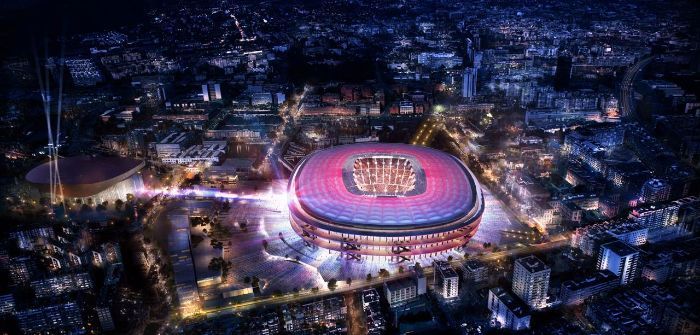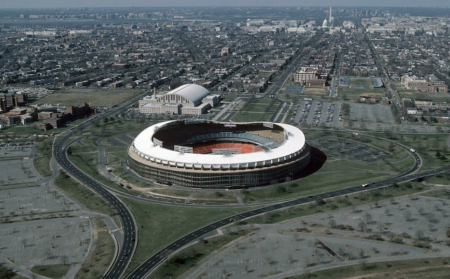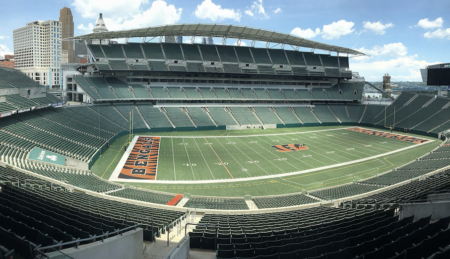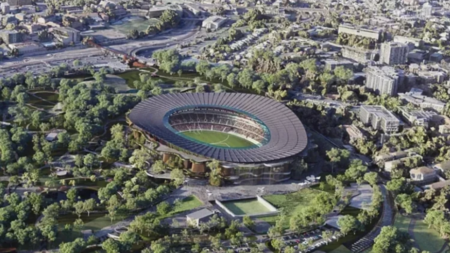FC Barcelona has announced that the Espai Barça jury has unanimously selected the bid by Nikken Sekkei and Pascual i Ausió Arquitectes as the winner of the tender for the design of the new Camp Nou stadium.
The jury – made up of five FCB members, three members of the Col•legi d’Arquitectes de Catalunya (COAC), and one member of the Barcelona City Council – made its decision after a review of the different proposals by a technical commission in accordance with the criteria established in the regulations and requirements for the tender. The decision was made at a meeting held in the Ricard Maxenchs Press Room at Camp Nou, following the exhibition of the four finalists.
In a statement by the Spanish soccer club, the Nikken Sekkei and Pascual i Ausió Arquitectes proposal was described as being “open, elegant, serene, timeless, Mediterranean and democratic.”
The statement continued, “It is also notable for its relationship with the environment, providing depth, creating shadows and making members the stars of the façade and of the open area at all times. The proposal presents a very subtle attempt to intervene in the environment to facilitate circulation and achieve diverse urban usage in the Barça Campus and guarantees a clear and safe construction.”
The Japanese company Nikken Sekkei is one of Asia’s leading architectural and engineering studios, and designed the Saitama Super Arena, the Big Swan Stadium in Niigata, and the Tokyo Dome, all in Japan. This team is working with the Catalan studio headed by Joan Pascual and Ramon Ausió, who have a long and proven history of experience in Barcelona involving residential buildings, office blocks and hotels, such as Hotel Diagonal Zero.
Work on the new Camp Nou is scheduled to start in the 2017/18 season and to end in the 2021/22 season. The list of requirements published for the tender stipulated that the new stadium should guarantee the best possible conditions for the enjoyment of soccer matches. All of the stadium terraces were to be covered, with excellent views from every seat and a number of measures were to be respected with regard to comfort for all users.
All seats will be covered and protected from adverse weather conditions (wind, sun and rain). The new roof must measure more than 505,900ft². All seats must have a perfect view of the pitch, with the first tier being made steeper. The whole stadium, as well as the new screens and video scoreboards, should be visible from all seats. The video scoreboards will use the latest high-resolution digital technology with LED type systems.
The second tier will be maintained but with improved accessibility and comfort. The third tier will be completed to reach the same height as the current lateral zone. Gates, comfort and services will be improved.
The capacity of the stadium will be increased to provide seating for 105,000 spectators. The spaces between seats will be improved and all seats are to be replaced with more comfortable and ergonomic designs. Each tier will be provided with carefully distributed places for persons with reduced mobility and other disabilities. Aisles will be widened and free from vertical connection hubs, thus making these spaces more comfortable for supporters. The existing stairways will be adapted to current standards and will be better distributed. The increase in capacity will be used to provide seats to persons on the season ticket waiting list and to provide the adapted seating that is currently lacking.
The draft project for the new Camp Nou will include criteria regarding energy saving and environmental sustainability in order to obtain the required quality certificates. In order to ensure the utmost safety for visiting supporters, and to minimize possible disturbance caused to other season ticket holders and spectators, the terraces shall be divided into sections, with separate entrances and passageways inside the stadium, as well as specific zones and services, being designated to these supporters. Catering and hospitality areas will be improved in all areas of the new Camp Nou.
The Espai Barça foresees construction of an underground parking lot, thus freeing up a large public area that shall be accessible and open to the neighborhood, located between the Camp Nou and the new Palau Blaugrana.
Images courtesy of FC Barcelona
March 10, 2016





